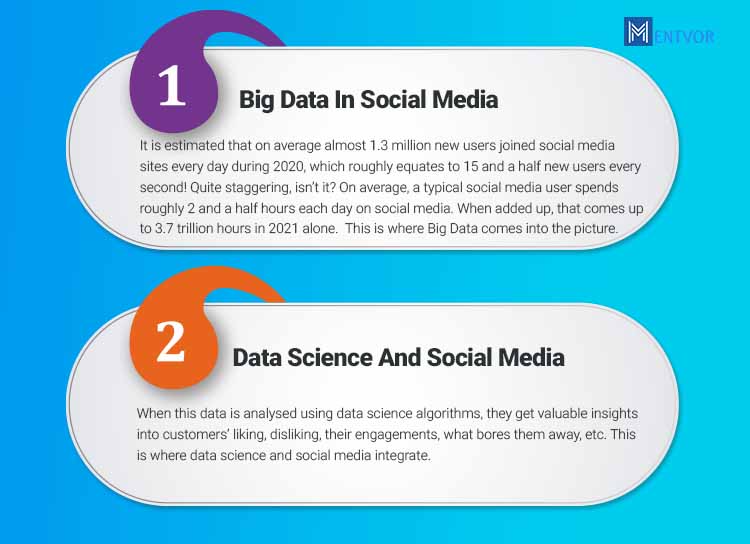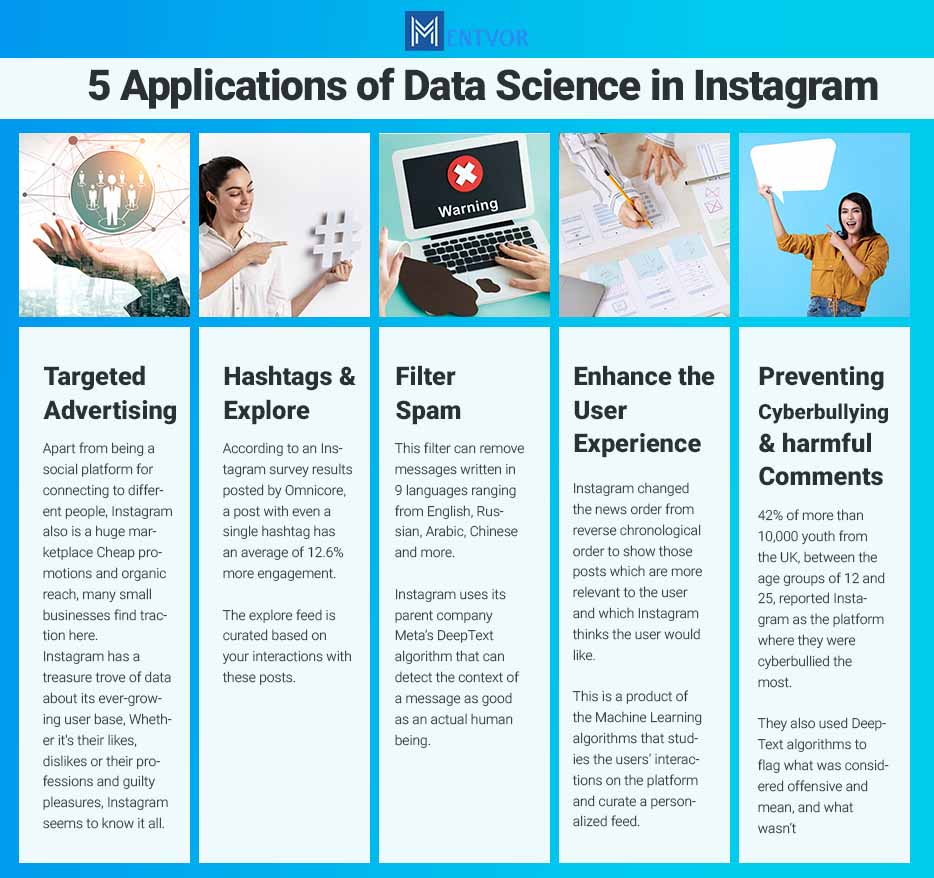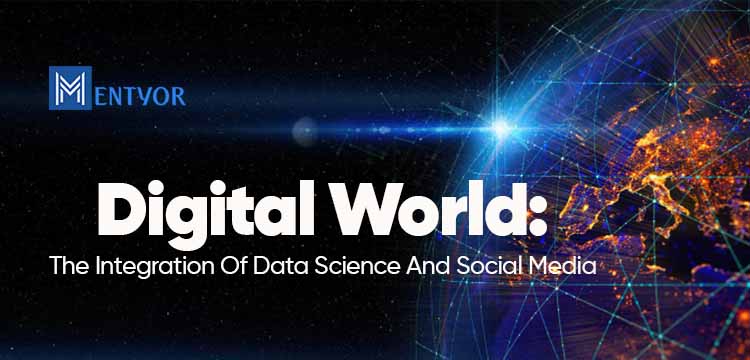Ever had those moments where you are at a restaurant but your friend won’t let you eat unless they have just the perfect “instagrammable” picture of the food?. I suppose most of us are familiar with this situation. This is because social media like Instagram has become such an unavoidable part of our daily lives.
Words like “Instagram” and “Instagrammable” have also been included in the US Merriam-Webster dictionary. This proves just how popular Instagram actually is.
According to the Digital 2021, Global overview report by Datreportal.com, 4.66 Billion people worldwide use the internet up until January 2021. That is almost 59.5% of the entire world’s population. And around 4.20 billion people around the world are social media users. That’s almost 53% of the entire world’s population. [1]
But the two things that social media owes its popularity to is Data science and AI. The mix of Data Science and Social Media has revolutionalised the way people socialize.
The integration of data science and social media served as a catalyst towards creating a social-media-savvy generation. Facebook and Instagram make use of Deep Learning technology to curate super relevant and interesting news feeds unique to each user. This is what keeps us hooked and makes us scroll through these social media pages for hours. And this is only just the tip of the iceberg. Keep reading as we delve deeper into how Instagram uses Big Data and AI and many more things!
Read our blog and know why Data Science Jobs are in Demand: Top 9 Reasons Why Data Science Jobs Are In Demand
How data science is used in Social Media?

Big Data In Social Media
To answer this question, let’s first look at how much data is being consumed in the world. According to the World Economic Forum, 463 EB (which is roughly the double amount of Gigabytes) data will be created in the world by 2025[2]. Up until 2019, the number of social media users was 3.46 Billion. But then came the covid-19 pandemic and everyone was forced to move into a digital world where social media were already the reigning champions. The numbers only got bigger and bigger since then.
It is estimated that on average almost 1.3 million new users joined social media sites every day during 2020, which roughly equates to 15 and a half new users every second! [1] Quite staggering, isn’t it? On average, a typical social media user spends roughly 2 and a half hours each day on social media. When added up, that comes up to 3.7 trillion hours in 2021 alone. [1] This is where Big Data comes into the picture.
Data Science And Social Media:
All the data amassed on social media sites are interactions of a normal human being. Whether it is pressing the heart on an Instagram post, or reacting to a meme on Facebook, everything generates data. When this data is analyzed using data science algorithms, they get valuable insights into customers’ liking, disliking, their engagements, what bores them away, etc. This is where data science and social media integrates.
The former CEO and Co-founder of Instagram even said back in 2012, “We’re also going to be a big data company” [3]
This distinct rise in social media usage has also led to a growing pile of structured and unstructured big data in social media. Data is amassed in almost all formats like Texts, Images, Photos, Videos, Geolocations and Hashtags.
Example Of Use Of Data Science In Social Media

An article on Harvard Business Review [4] chronicles how organized data became a game-changer for LinkedIn and propelled it to its current status. The feature that many social media users may be familiar with is known as “People You May Know”. The main feature which helps social media, to be well, social as it connects thousands of people who may or may not know each other yet.
If you think it’s only by chance that your far relatives ended in your friends’ suggestion list, then think again. It’s a clever data algorithm trick that makes you want to use these Social sites more and more. And guess who runs the show behind these algorithms? Yep, the data scientists. This is just one example of how data science and social media blend smoothly.
Large piles of unorganized data which can be mined into a base full of useful information can easily help to double, or even triple your businesses. Social media has users expressing their opinions across a host of different genres like entertainment, journalism, sports, education etc.
Data science in social media includes algorithms like big data analytics, data mining, Machine Learning and Artificial Intelligence. These processes are used for data discovery, data mining and also predictive modelling. For example, if a big company wishes to market their product on social media, then it could identify the patterns in customer buying behaviour through these algorithms.
Predictive modelling and analysis including cluster models, regression analysis and cluster filtering are part of the Machine Learning algorithms. By analyzing a person’s interactions across different genres, they could predict whether a customer would be interested in buying a certain product or not. If they are interested when would be the right time, etc.
Now that we have a tiny idea of what Data Science and social media can do together, let us explore how Instagram uses Big Data and AI
Read blog about Best Universities in USA for Data Science: A Guide to 22 Best Data Science Universities in USA
5 Applications of Data Science in Instagram

Targeted Advertising
The most used and profitable application of data science in Instagram is Targeted Advertising. Apart from being a social platform for connecting to different people, Instagram also is a huge marketplace. With cheap promotions and organic reach, many small businesses find traction here. But Instagram, just like its parent company Meta, also allows people to put paid advertising campaigns on its platform.
Instagram has a treasure trove of data about its ever-growing user base, Whether it’s their likes, dislikes or their professions and guilty pleasures, Instagram seems to know it all. This Big Data in Social Media like Instagram helps in targeting people based on these preferences.
For example, I am a matrimonial site that wants to run an ad campaign on Instagram to promote my services. Since not everyone is going to be my customer base, I could choose a specific group who would see my advertisements. This targeted group can be chosen by using demographics like age (between 24-40 ), marital status, even their interactions with specific dating pages, etc. By doing this, I make sure that my ads only reach my targeted audience and do not get wasted. This high specificity on Instagram is an example of Data science in Social Media.
Hashtags and Explore
Hashtags are a way of grouping a lot of related topics together. According to an Instagram survey results posted by Omnicore, a post with even a single hashtag has an average of 12.6% more engagement. [5] The explore feed is curated based on your interactions with these posts. For example, if you were to like posts with the hashtag food more, then your explore page will contain more posts related to food.
This is just another application of data science in Instagram to make the social site more smooth, clean and easy to navigate.
Filter Spam
Another innovative feature using data science in Instagram is the Spam Filter. Instagram uses AI to remove spam messages and pages. This filter can remove messages written in 9 languages ranging from English, Russian, Arabic, Chinese and more. If the spam filter detects spam messages, they are removed automatically. Instagram uses its parent company Meta’s DeepText algorithm that can detect the context of a message as good as an actual human being.
Enhance the User Experience
The reason why Instagram is so popular is because of its smooth and interactive user experience. As soon as we open the app, we land on the news feed. Instagram changed the news order from reverse chronological order to show those posts which are more relevant to the user and which Instagram thinks the user would like. This is a product of the Machine Learning algorithms that studies the users’ interactions on the platform and curate a personalized feed.
Preventing Cyberbullying and harmful Comments
A survey conducted by Ditch the Label showed that 42% of more than 10,000 youth from the UK, between the age groups of 12 and 25, reported Instagram as the platform where they were cyberbullied the most. Given that Instagram is mostly a visual and social platform, body Shaming and mean comments have become a norm over there. To fight this, Instagram used Machine Learning to automatically remove posts that were offensive. They also used DeepText algorithms to flag what was considered offensive and mean, and what wasn’t. Offensive posts and comments were flagged manually to teach the algorithm how to identify the same.
Apart from this, Instagram also allows users to disable certain words from their comments that are offensive. Users can even turn off their comments section as a whole.
Know how To Become Data Scientist in 2022: How To Become A Data Scientist In 2022: A Complete Guide To Data Science
FAQs
Q1. Does Instagram use Data Mining?
A1. Instagram uses data mining as it collects information not only just for advertisements purposes. But also to detect suspicious activity on your account like unverified log-ins. Data Science and Instagram work in various ways to protect security.
Q2. How does Instagram use your data?
A2. Instagram uses your data to enhance the user experience and the entire interface of the app. It also uses the data for targeted advertising.
Q3. Can Instagram read our DMs?
A3. No, Instagram cannot read your DMs. But it can collect the data for things like when you are active the most of the users you speak to the most.
Conclusion
With the world becoming digitized by the second, social media has become the new place for hanging out. Whether it is meeting new people or discussing your opinions on politics, entertainment or sport, there’s a niche for everyone. As such social media, whether it be Facebook or LinkedIn, keeps getting more popular.
Add Data science in Instagram and it has elevated the user experience. In a pandemic driven world with lockdowns and quarantines, social media was a source of relaxation for many.
References
[1] Kemp, S. (2021, October 22). Digital 2021: Global Overview Report. DataReportal – Global Digital Insights. https://datareportal.com/reports/digital-2021-global-overview-report
[2] How much data is generated each day? (2020, February 8). World Economic Forum. https://www.weforum.org/agenda/2019/04/how-much-data-is-generated-each-day-cf4bddf29f/
[3] Tam, D. (2012, November 5). Beyond hashtags: Instagram’s next challenge is tackling big data. CNET. https://www.cnet.com/tech/services-and-software/beyond-hashtags-instagrams-next-challenge-is-tackling-big-data/
[4] Davenport And Patil, T. H. D. J. (2012, October). Data Scientist: The Sexiest Job of the 21st Century. Harvard Business Review. https://hbr.org/2012/10/data-scientist-the-sexiest-job-of-the-21st-century
[5] Aslam, S. (2022, January 4). Instagram by the Numbers (2022): Stats, Demographics & Fun Facts. Omnicore. https://www.omnicoreagency.com/instagram-statistics/


 WhatsApp
WhatsApp